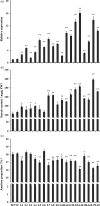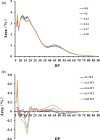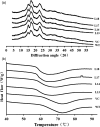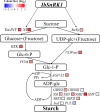A sucrose non-fermenting-1-related protein kinase-1 gene, IbSnRK1, improves starch content, composition, granule size, degree of crystallinity and gelatinization in transgenic sweet potato
- PMID: 29734529
- PMCID: PMC6330544
- DOI: 10.1111/pbi.12944
A sucrose non-fermenting-1-related protein kinase-1 gene, IbSnRK1, improves starch content, composition, granule size, degree of crystallinity and gelatinization in transgenic sweet potato
Abstract
Sucrose non-fermenting-1-related protein kinase-1 (SnRK1) is an essential energy-sensing regulator and plays a key role in the global control of carbohydrate metabolism. The SnRK1 gene has been found to increase starch accumulation in several plant species. However, its roles in improving starch quality have not been reported to date. In this study, we found that the IbSnRK1 gene was highly expressed in the storage roots of sweet potato and strongly induced by exogenous sucrose. Its expression followed the circandian rhythm. Its overexpression not only increased starch content, but also decreased proportion of amylose, enlarged granule size and improved degree of crystallinity and gelatinization in transgenic sweet potato, which revealed, for the first time, the important roles of SnRK1 in improving starch quality of plants. The genes involved in starch biosynthesis pathway were systematically up-regulated, and the content of ADP-glucose as an important precursor for starch biosynthesis and the activities of key enzymes were significantly increased in transgenic sweet potato. These findings indicate that IbSnRK1 improves starch content and quality through systematical up-regulation of the genes and the increase in key enzyme activities involved in starch biosynthesis pathway in transgenic sweet potato. This gene has the potential to improve starch content and quality in sweet potato and other plants.
Keywords: IbSnRK1; starch content; starch quality; sweet potato.
© 2018 The Authors. Plant Biotechnology Journal published by Society for Experimental Biology and The Association of Applied Biologists and John Wiley & Sons Ltd.
Conflict of interest statement
The authors declare no conflict of interest.
Figures









Similar articles
-
Engineering Properties of Sweet Potato Starch for Industrial Applications by Biotechnological Techniques including Genome Editing.Int J Mol Sci. 2021 Sep 2;22(17):9533. doi: 10.3390/ijms22179533. Int J Mol Sci. 2021. PMID: 34502441 Free PMC article. Review.
-
A soluble starch synthase I gene, IbSSI, alters the content, composition, granule size and structure of starch in transgenic sweet potato.Sci Rep. 2017 May 24;7(1):2315. doi: 10.1038/s41598-017-02481-x. Sci Rep. 2017. PMID: 28539660 Free PMC article.
-
[Functional analysis on sucrose transporters in sweet potato].Sheng Wu Gong Cheng Xue Bao. 2023 Jul 25;39(7):2772-2793. doi: 10.13345/j.cjb.220979. Sheng Wu Gong Cheng Xue Bao. 2023. PMID: 37584131 Chinese.
-
Inhibition of the gene expression for granule-bound starch synthase I by RNA interference in sweet potato plants.Plant Cell Rep. 2007 Oct;26(10):1801-7. doi: 10.1007/s00299-007-0396-6. Epub 2007 Jul 12. Plant Cell Rep. 2007. PMID: 17622537
-
Understanding starch biosynthesis in potatoes for metabolic engineering to improve starch quality: A detailed review.Carbohydr Polym. 2024 Dec 15;346:122592. doi: 10.1016/j.carbpol.2024.122592. Epub 2024 Aug 8. Carbohydr Polym. 2024. PMID: 39245484 Review.
Cited by
-
Possible Mechanism of Sucrose and Trehalose-6-Phosphate in Regulating the Secondary Flower on the Strong Upright Spring Shoots of Blueberry Planted in Greenhouse.Plants (Basel). 2024 Aug 23;13(17):2350. doi: 10.3390/plants13172350. Plants (Basel). 2024. PMID: 39273834 Free PMC article.
-
Comparative Transcriptome Profiling Reveals the Genes Involved in Storage Root Expansion in Sweetpotato (Ipomoea batatas (L.) Lam.).Genes (Basel). 2022 Jun 27;13(7):1156. doi: 10.3390/genes13071156. Genes (Basel). 2022. PMID: 35885939 Free PMC article.
-
Engineering Properties of Sweet Potato Starch for Industrial Applications by Biotechnological Techniques including Genome Editing.Int J Mol Sci. 2021 Sep 2;22(17):9533. doi: 10.3390/ijms22179533. Int J Mol Sci. 2021. PMID: 34502441 Free PMC article. Review.
-
Combined ultrasound and germination treatment on the fine structure of highland barley starch.Ultrason Sonochem. 2023 May;95:106394. doi: 10.1016/j.ultsonch.2023.106394. Epub 2023 Mar 31. Ultrason Sonochem. 2023. PMID: 37018984 Free PMC article.
-
Molecular Cloning, Characterization, and Application of a Novel Multifunctional Isoamylase (MIsA) from Myxococcus sp. Strain V11.Foods. 2024 Oct 30;13(21):3481. doi: 10.3390/foods13213481. Foods. 2024. PMID: 39517265 Free PMC article.
References
-
- Abe, N. , Nakamura, Y. and Fujita, N. (2013) Thermal properties, morphology of starch granules and crystallinity of endosperm starch in SSI and BE isozymes double mutant lines. J. Appl. glycosci. 60, 171–176.
-
- Ahn, Y.O. , Kim, S.H. , Kim, C.Y. , Lee, J.S. , Kwak, S.S. and Lee, H.S. (2010) Exogenous sucrose utilization and starch biosynthesis among sweetpotato cultivars. Carbohyd. Res. 345, 55–60. - PubMed
-
- Bahaji, A. , Li, J. , Sánchez‐López, Á.M. , Baroja‐Fernández, E. , Muñoz, F.J. , Ovecka, M. , Almagro, G. et al. (2014) Starch biosynthesis, its regulation and biotechnological approaches to improve crop yields. Biotechnol. Adv. 32, 87–106. - PubMed
-
- Ball, S.G. and Morell, M.K. (2003) From bacterial glycogen to starch: understanding the biogenesis of the plant starch granule. Annu. Rev. Plant Biol. 54, 207–233. - PubMed
Publication types
MeSH terms
Substances
Grants and funding
LinkOut - more resources
Full Text Sources
Other Literature Sources

